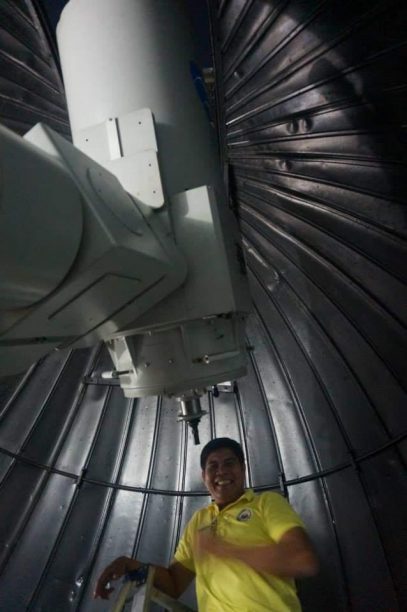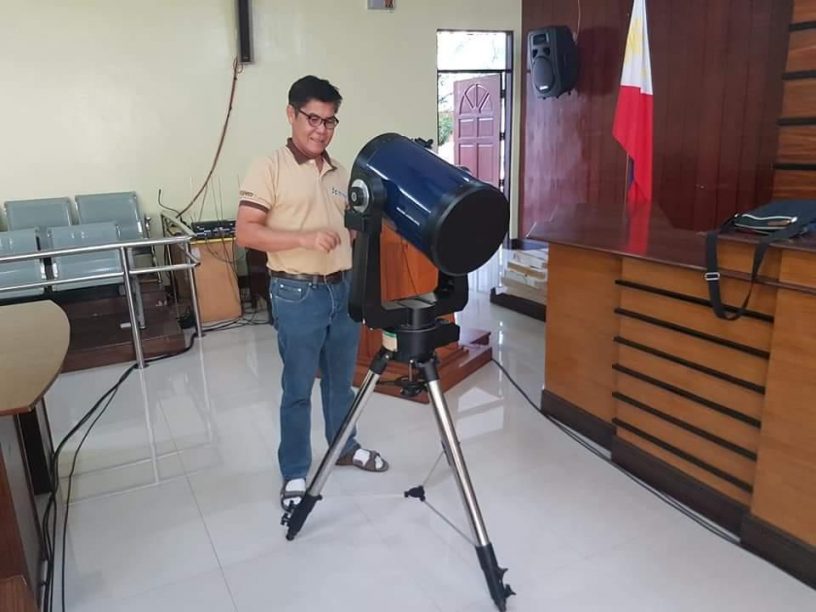Time flies when you’re having fun, and seems to slow down when you’re in a less desirable situation. But time is more than the numbers glowing on our phones and watches; it is a fascinating ode to astronomy.
 Raymundo with a 45-cm GOTO Telescope, the largest optimal telescope in the country, at the PAGASA Astronomical Observatory in the University of the Philippines.
Raymundo with a 45-cm GOTO Telescope, the largest optimal telescope in the country, at the PAGASA Astronomical Observatory in the University of the Philippines.
When Electrical Engineer Mario Raymundo first entered the Philippine Atmospheric, Geophysical and Astronomical Services Administration (PAGASA) office in 1993, he was assigned to the weather’s bureau’s time service unit. Here, he learned how time could be measured by observing the movement of celestial bodies, and how time zones in different parts of the world are based on the fact that it takes the Earth one hour to turn 15 degrees.
As time went by, it seemed almost natural for Raymundo to gradually expand his knowledge and duties to include astronomy. “As an engineer, I was well-versed in mathematics, including trigonometry. But in astronomy, I learned spherical trigonometry to make observations on the celestial bodies.”
Decades later, Raymundo is now chief of the PAGASA Astronomical Observation and Time Service Unit. “We use a 45-centimeter telescope to observe variable stars. During the daytime, we study and photograph sun spots.” Sun spots or dark spots that appear on the Sun’s photosphere may have an effect on the Earth’s weather patterns. Meanwhile, variable stars or stars that change their brightness are studied to possibly discover other stars and signs of life in the galaxy.
 Raymundo with a compound telescope
Raymundo with a compound telescope
Astronomy for Filipinos
Raymundo admits that the study of astronomy in the Philippines is limited because of the lack of funding for high-cost equipment. “Astronomy equipment is very expensive. A 1-meter telescope alone costs a million (US) dollars, which is roughly 50 million pesos. You can feed a lot of Filipinos with that amount.” Still, Raymundo believes that PAGASA provides a good foundation for future Filipino astronomers. “We have to start somewhere to impart the knowledge to future generations. Before the pandemic, we regularly visited schools with our mobile planetarium to conduct lectures.”
Despite the challenges, Raymundo says astronomy remains significant for Filipinos. “A lot of Filipinos are hungry for astronomical knowledge. In science textbooks in schools, only 7 to 8 pages are dedicated to astronomy, offering only general facts. When we conduct lectures, we give students direct knowledge. Through the planetarium, they better understand why celestial bodies are positioned in certain ways, and the importance of the Polaris or North Star. It’s easier to explain things that way.”
 Annular Solar Eclipse in December 2019 in Balut Island in Saranggani, Davao Occidental
Annular Solar Eclipse in December 2019 in Balut Island in Saranggani, Davao Occidental
 Training in Spain on Astronomical Observation which lasted for several months
Training in Spain on Astronomical Observation which lasted for several months
Astronomy saves lives
But astronomy is not only a passive observation of the skies; it can also save lives. In 2013, an asteroid about the size of a six-story building blasted over Chelyabinsk in Russia. Its explosion generated a shock wave that shattered glass and injured over a thousand people. “Outer space can bring disasters,” Raymundo says. “In reality, thousands of meteors enter our planet, but they usually disintegrate before hitting our surface. The one that exploded in Russia was unexpected, so we need people to be aware that this kind of disaster is possible.”
On July 15, Panahon TV will host a free webinar called Understanding Space with Raymundo as the speaker. “I’m excited because it’s my first time to conduct an online lecture. It’s a different approach and I’m looking forward to the results.” When asked what he’s excited to share with the webinar participants, Raymundo says, “I hope to better explain to them the things they read in books. Everything from the constellations to the zodiac, I will be able to describe in detail.”
Catch Chief of PAGASA Astronomical Observation and Time Service Unit Mario Raymundo in Panahon TV’s free webinar, Understanding Space, on July 15, 2020 at 2 pm. To register, click here: https://bit.ly/2Z7TJa4
What do you want to be when you grow up? For sure, some kids would say: to become an astronaut. In fact, we all probably dreamed of the same thing at some point in our lives. There’s something about outer space that fascinates us. Proof of this are all the space-oriented books, movies and TV shows present in our pop culture.
But space exploration entails great discipline. Astronauts are trained through a human spaceflight program to either command, pilot or serve as a crew member of a spacecraft. If you’re one of those dreaming to become an astronaut, here are some of the things you need to do before handing in that application:
STUDY FIRST!
One of the basic requirements of being an astronaut is having a bachelor’s degree in engineering, biological science, physical science or mathematics. According to the National Aeronautics and Space Administration (NASA), the International Space Station (ISS) can only accommodate six persons at a time because each exploration is quite pricey. That is why it is vital for NASA to send only highly qualified individuals to ensure the success of the mission.
BE PHYSICALLY FIT.
For obvious reasons, being healthy and fit is also one of NASA’s basic requirements to become an astronaut. You must have:
• A distant visual acuity of 20/100 or better uncorrected, correctable to 20/20 each eye
• A sitting blood pressure of 140/190
• Height between 62 and 75 inches tall
These basic physical characteristics ensure that you would be able to perform your job well while you are in orbit. An emergency flight back to earth due to a health concern may not be feasible.

Astronauts in training
Image source: www.wordpress.com; www.jsc.nasa.gov
MORE TRAINING!
Once accepted into the program, you can’t be called a full-fledged astronaut just yet. Candidates must undergo a two-year rigid training in order to be space-ready. This includes learning about the International Space Station and the basics of spaceflight. Candidates also undergo military water training, swimming tests and are exposed to extreme conditions, such as high and low atmospheric pressures. These rigorous activities are designed to prepare potential astronauts to what they may experience in orbit.
However, there’s no assurance that right after training, successful astronauts will immediately go to space. Most of NASA’s astronauts work as support crew to other astronauts in orbit. This is another form of training for them to gain more knowledge and skills so that when it’s their turn to fly into orbit, they will be better equipped.
Once an astronaut is scheduled for a mission, he spends a few more years of training, which includes more classroom learning and simulation trainings—but this time, these would be held all over the world. He will also get a chance to train with his crewmates so they will be more familiar with each other and their specific responsibilities.
It should also be noted that astronauts don’t just spend their time working solely with NASA. They also work with the agency’s international partners, such as training facilities in Canada.
We all know that the universe is vast with hidden mysteries waiting to be discovered. If you dream of being an astronaut, you must be dedicated enough to face all the challenges that you might encounter. When you love what you’re doing, you’ll be able to surpass everything in order to reach your dream—and yes, even outer space.
Sources:
http://www.space.com/25786-how-to-become-an-astronaut.html
https://www.nasa.gov/audience/forstudents/postsecondary/features/F_Astronaut_Requirements.html
http://science.howstuffworks.com/question5341.htm
https://www.quora.com/Why-do-NASA-astronauts-need-to-have-a-degree-in-math-or-science
By: Jeroh P. Hiyastro – Panahon.TV Intern

Aside from preparing your Christmas presents and gearing up for get-togethers, another exciting thing to do this December is to watch the skies—not to wait for Santa and his reindeer, but to witness the spectacular meteors!
Meteoroids VS Meteors & Meteorites
Meteoroids are small rocks or particles orbiting around the sun. Once a meteoroid enters the Earth’s atmosphere, it vaporizes and becomes a meteor, also known as a “shooting star” or bulalakaw in Tagalog.
According to the National Aeronautics and Space Administration (NASA), as this space rock falls toward the Earth, the air resistance or drag makes it extremely hot. So what we see is not actually the rock, but the bright streak or the glowing hot air as it approaches the atmosphere.
If a small asteroid or large meteoroid survives its entry or passage through the atmosphere and lands on the surface of the Earth, it is called a meteorite.
December is an ideal month for astronomy enthusiasts as the Geminids Meteor Shower lights up the sky from December 4 to 17, 2015. Appearing to come from the constellation of Gemini, Geminids meteors do not originate from a comet, but from an asteroid. Meteors from this shower are very rocky and are more visible.
NASA explains that these meteors originated from the Asteroid 3200 Phaethon, which takes 1.4 years to orbit the sun. Phaethon is a small asteroid with a diameter of 5.10 kilometers.
Dubbed as a “dead comet”, the Phaethon does not develop a cometary tail when it passes by the sun. Its spectra look like a rocky asteroid instead.
3200 Phaethon was discovered by the Infrared Astronomial Satellite on October 11, 1983. Due to its close distance to the sun, Phaethon is named after the character in Greek mythology that drove the chariot of Helios (the God of Sun). But it was the astronomer, Fred Whipple, who recognized that the Geminids meteor shower originated from Phaethon.
The Geminids is considered as one of the best and most reliable annual meteor showers. So mark your calendars now! Its peak activity is on the late night of December 14 until the early morning hours of December 15. PAGASA says that if good weather permits, an observer can witness around 40 meteors per hour.

Viewing Tips
– Get as far away from urban pollution as possible. Find a location with a clear or almost cloudless night sky.
– Search for the darkest patch of sky.
– Clothing matters! Wear clothes that suit cold overnight weather.
– Bring something comfortable for you to sit or lie down.
– It takes time, so be patient.
– Put away the telescope or binoculars, which may reduce the amount of sky you can see at once.
– Relax your eyes. Do not look at any specific spot.
– Avoid looking at your gadgets or any other light source which could disturb night vision.
– If you have to look at something on the surface of the Earth, use a red light.
Sources:
NASA
PAGASA-DOST
www.universetoday.com

